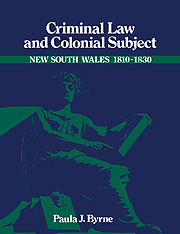5 - The Creation of Bushranging
Published online by Cambridge University Press: 15 December 2009
Summary
Women who brought close acquaintances to courts shaped the law to their own purposes. In rape cases there was considerable resistance to the woman being heard. This was due partly to the requirements of statute law, the attitudes of magistrates and the opinions of local populations. We can see, then, both this shaping of law to local purposes and resistance to it. Such a relationship to law is even more apparent in the offence of bushranging. This offence was created both by local perceptions and by the interpretations of these by the administration. It was a crisis which was to provide opportunity for the administration to react strongly without regard for ‘freedom’ and its connotations. The response to this policing created its own culture.
Thomas Scott, superintendent of the sugar plantations at Port Macquarie, appeared before the Port Macquarie Bench of Magistrates on 13 June 1826. He claimed that on the night of 2 June he was asleep in his house when his servant woke him. Three men were in the house. They requested a light and when the servant was slow about it, one of them stood over him with a cutlass in a menacing attitude. The men took flour, hemp, knives and government property. In leaving the house they said they had a great party to join from the plains and they intended to murder Keegan, one of the plantation overseers, and Charm, the overseer of the agricultural establishment.
- Type
- Chapter
- Information
- Criminal Law and Colonial Subject , pp. 129 - 152Publisher: Cambridge University PressPrint publication year: 1993



